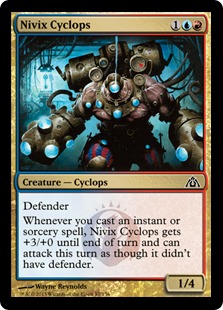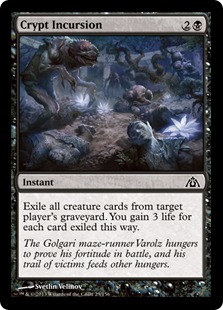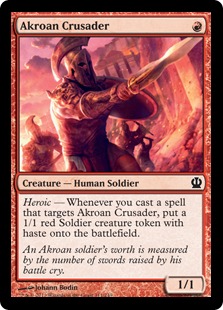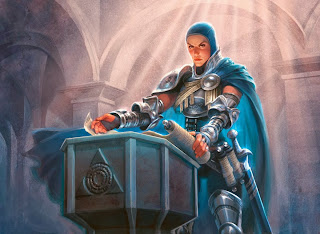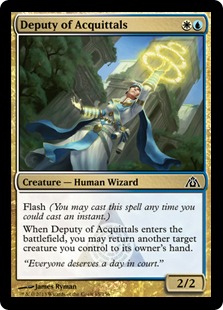For this week, I decided to devote all three of my blog posts to the
Dimir Mill deck that captured the trophy for
MPDC 23.02.
On Sunday, I wrote a brief introduction to this archetype. Then,
on Wednesday, I wrote about some strategies that can successfully counter what this deck is trying to do. While these strategies go a long way to defeating this archetype, the determined Dimir Mill players is not without options. So today I want to briefly discuss some potential ways that Dimir Mill can emerge victorious:
1. The biggest weakness of the build that won MPDC 23.02 is its inability to successfully mill out an opponent who doesn't cast any spells. What is needed, then, are some cards that overcome this shortcoming. The most obvious answer is
Tome Scour, which for a single blue mana mills an opponent for 5 cards. All other things being equal, if you manage to see most of your deck and thus cast all four copies, this should be enough to counter the additional cards in your opponent's library gained through Sideboarding and aggressive mulligans.
2. Of course, the reason Tome Scour wasn't included in the original list is that its essentially an "aggro" mill card, in that it doesn't convey any additional advantages. For that reason, one could argue that a better solution would be creature-based mill. This would not only help solve the original shortcoming, but would also force your opponent to deal with additional creature threats. This, in turn, forces him or her to cast more spells, and this in turn gives you a better chance to cast counterspells and removal. Let's look at three such possibilities.
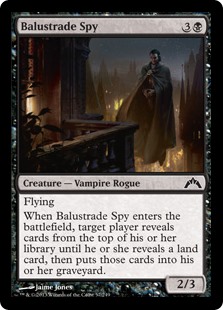
A. Gatecrash unveiled a special "mill" mechanic where an opponent reveals cards until he or she reveals a land, and then all those cards get put in the Graveyard. Balustrade Spy is perfectly positioned to take full advantage of this ability. While the amount of cards it mills will obviously be somewhat random, in a typical deck it will average between 2 and 3 cards, with a much higher potential. Even better, a 2/3 flyer is a significant threat, which your opponent cannot simply ignore turn after turn.

B. The second option comes from Return to Ravnica in the form of Doorkeeper, a much more typical Blue creature with the ability to mill cards. Paying two a blue mana to mill a single card from your opponent's library is not very good, but in multiples this has the potential to mill quite a few cards over the course of a game. Of course, since this doesn't otherwise threaten your opponent, I would judge it weaker than Balustrade Spy, although it will probably mill more cards over the course of a game.
C. The final option is Returned Centaur. This is similar to Balustrade Spy, but with a guaranteed four cards mill when it comes into play. While it isn't quite as potent a threat as the Balustrade Spy, it consistently mills for almost as many cards as Tome Scour while still presenting a threat that your opponent cannot simply ignore. In my opinion, this is probably the most consistent creature-based milling option, and would be the first option I would want to test further.
3. It should also be mentioned that the Sideboarding trick works almost as well for you as it does for your opponent. Especially in Game 3 if you've already seen your opponent use this strategy, it makes sense to utilize it yourself. While weakening your overall plan, the game is all but guaranteed to go long anyway, and so you should be able to overcome the dilution of your library.
In closing, I confess that I have to test any of this. But if I were going to go down this route, these would be the options I would start with.
So what about you? Any solid options that I missed? Do you have any other tips, either for improving the Dimir Mill deck or defeating it more consistently? As always, I'd love to hear your thoughts. Thanks for reading.










